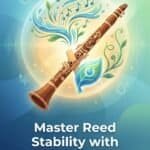Maintain clarinet reeds at 40-60% relative humidity using humidity packs (such as Boveda), hydrogel beads, or a slightly damp sponge in a vented soap dish. Monitor with a small digital hygrometer, avoid direct contact between humidifiers and reeds or instrument, and adjust or remove humidifiers if readings fall below 40% or rise above 65%.
Why Humidity Matters for Clarinet Reeds
Clarinet reeds are made from Arundo donax cane, a natural grass that constantly exchanges moisture with the air. When humidity is stable, the reed keeps a predictable balance of stiffness and flexibility. When humidity swings too low or too high, the reed changes shape, strength, and response, which directly affects tone, articulation, and reliability.
The anatomy of a reed explains why humidity matters so much. The thin tip vibrates most easily, the heart carries strength, and the back and stock anchor the reed to the mouthpiece. Dry conditions shrink the cane and can cause micro-cracks at the tip. Excess moisture swells the fibers, softens the heart, and can twist the reed, leading to warping and uneven response.
Synthetic reeds from brands like Legere or Fibracell react less to humidity, but they still sit in the same case environment as cane reeds. High humidity can still promote mold on the reed table or in the case lining. For players who mix cane and synthetic reeds, controlling reed case humidity protects both the reeds and the case interior from moisture damage.
Clarinet cases and reed cases form small microclimates. The seal, lining, and internal padding all influence how quickly humidity changes inside. A well-controlled reed case reduces daily swings that happen when you move between practice rooms, outdoor venues, and air conditioned spaces. This stability is what gives reeds a longer, more predictable playing life.
Recommended Humidity Ranges and What They Mean (40-60% vs 40-70%)
Most clarinetists aim to keep reeds between 40 and 60% relative humidity. This range closely matches comfortable indoor conditions and keeps cane near its natural equilibrium moisture. Within this band, reeds stay flexible without becoming soggy, and they are less likely to crack, warp, or grow mold during normal use and storage.
You will sometimes see recommendations of 40-70% relative humidity. The upper part of that range, 60-70%, can work in very dry climates where reeds dry out quickly between sessions. However, the closer you get to 70%, the higher the risk of mold growth, swelling at the reed tip, and overly soft response, especially if reeds are stored wet.
Think of 40-60% as the ideal target zone and 60-65% as a short term buffer. Above about 65-70%, you should treat the environment as too humid for long term storage. At those levels, case lining, corks, and pads can also begin to absorb excess moisture, which can affect keywork regulation and pad seating over time.
Below 40% relative humidity, cane loses bound water and becomes brittle. Reeds may feel harder at first, then suddenly chip or crack at the tip. A reed stored around 20-30% RH for several days may never fully recover its original response, even if rehydrated. This is why consistent mid-range humidity is more important than occasional short spikes.
Players in very dry regions like Colorado or Arizona may choose 50-60% as a practical working range. In humid regions like Florida or Singapore, the goal may be to keep reeds from living above 70% by using desiccant packs in the main clarinet case while still using mild humidification inside a sealed reed case. The principle is balance, not maximum moisture.
How to Measure Case Humidity – Choosing and Using a Hygrometer
A small digital hygrometer is the most reliable way to know what is happening inside your clarinet reed case. Guessing from room conditions is not enough, because the case lining, seal, and humidifiers create a different microclimate. A dedicated hygrometer gives you real numbers so you can adjust packs or sponges before problems appear.
Look for a compact hygrometer designed for cigar humidors or instrument cases. Brands like Govee, Inkbird, and Oasis make models with 1-2% resolution and reasonable accuracy. A unit that displays both temperature and relative humidity is ideal, since temperature changes affect how much water air can hold and how quickly reeds dry or swell.
Place the hygrometer where it reads the same air your reeds experience. In a dedicated reed case, this usually means a corner away from direct contact with reeds but not blocked by foam. In a full clarinet case, position it near the reed compartment or mouthpiece area, not buried under cleaning cloths or accessories.
Allow at least 30-60 minutes after closing the case for readings to stabilize. When you first add a humidity pack or damp sponge, the numbers may drift for several hours. Check at the same time each day for a week to learn how your case behaves. If your hygrometer allows calibration, compare it with a known reference, like a salt test at 75% RH, and adjust if needed.
Some Bluetooth hygrometers can log data over time. This can be helpful for teachers, technicians, or serious students tracking how cases respond during travel or between rehearsal spaces. Even a simple, inexpensive unit, though, is far better than guessing. Once you know your baseline, you can choose the lightest humidification method that keeps readings in the target range.
Humidity Control Methods: Commercial Packs, Hydrogels, and DIY Sponge Method
There are three main ways to control clarinet reed case humidity: commercial humidity packs, hydrogel beads, and a simple damp sponge method. Each approach has advantages depending on your climate, budget, and how many cases you maintain. The key is to use a method that is stable, safe, and easy for you to monitor regularly.
Commercial Humidity Packs
Commercial packs, such as Boveda or D'Addario Humidipak, regulate humidity by absorbing and releasing moisture to maintain a specific relative humidity. Common ratings include 49%, 58%, and 62%. For clarinet reeds, a 49-58% pack in a sealed reed case usually keeps reeds in the ideal 40-60% zone without daily attention.
Use one or two small packs for a standard 8-12 reed case. Keep the pack in its breathable wrapper or pouch, and place it in a separate compartment or under a perforated divider so it never touches reeds directly. Replace packs when they feel hard or when your hygrometer shows they no longer hold the target range.
Hydrogel Beads
Hydrogel beads, often sold as floral beads or cigar humidifier refills, absorb water and slowly release moisture into the air. When used in a vented container, they can maintain moderate humidity in a reed case. They are inexpensive and reusable, which appeals to students and community players managing multiple cases.
Hydrogel beads must be used carefully. Overfilled containers or fully saturated beads can push humidity above 70%. Use a small number of beads in a ventilated capsule or soap dish with holes. Check your hygrometer daily at first, and let beads partially dry if humidity rises above 60-65% for more than a day.
DIY Sponge Method
The DIY sponge method uses a small, clean sponge in a vented soap dish or plastic container to add gentle moisture. This method is highly adjustable and very affordable. It works especially well in very dry climates where commercial packs dry out quickly or where students need a low cost solution.
Always use a new, unscented sponge and a container with holes so moisture can escape slowly. The sponge should be only slightly damp, never dripping. Excess water can leak, damage case lining, or soak reeds. The goal is a mild, steady source of moisture that you can refresh every few days based on hygrometer readings.
Safe Placement and Case Sealing Best Practices
Where you place humidifiers in your clarinet reed case matters as much as which method you choose. The goal is even humidity around the reeds without direct wet contact. Poor placement can lead to localized swelling, mold spots, or water damage to pads, corks, and metal parts inside the main clarinet case.
In a dedicated reed case, position humidity packs, hydrogels, or sponges in a separate compartment, under a perforated tray, or along a side wall. Ensure there is at least 1-2 cm of air gap between the humidifier and any reed tip. Never tape packs directly onto the reed tray or lay reeds directly on top of a humidifier.
In a full clarinet case, keep humidifiers away from pads and keywork. A small vented container can sit near the barrel or mouthpiece area, as long as it cannot tip over. Avoid placing humidifiers under the clarinet body where gravity could pull moisture toward pads or tenon corks if a leak occurs.
Case sealing is another important factor. A well sealed reed case with a gasket or tight latch will hold humidity more consistently and require less frequent humidifier maintenance. If your case closes loosely or has gaps, humidity will fluctuate more with room conditions. In that situation, consider upgrading to a better sealed reed case or adding a small zip bag around the reed case itself.
Always let reeds surface dry before closing the case. After playing, wipe excess moisture from the reed with a clean cloth or your thumb, then allow 5-10 minutes of air drying before placing it in the case. This simple step reduces mold risk and prevents localized over hydration at the reed table and tip.
Maintenance Schedule: Checking, Replacing Packs, and Case Checks
A consistent maintenance schedule keeps clarinet reed case humidity in the safe zone without guesswork. Think in terms of three routines: daily quick checks, weekly adjustments, and monthly deeper inspections. Once these habits are set, your reeds will behave more predictably and last longer, saving both practice time and money.
Daily, glance at your hygrometer when you open the case. If readings sit between 40 and 60% RH, you are on track. If they drift below 40% or above 65%, make a note to adjust humidifiers later that day. Also look briefly at the reeds for any obvious warping, discoloration, or mold spots before you play.
Weekly, check the condition of humidity packs, beads, or sponges. For commercial packs, feel for stiffness or crusty edges, which indicate the pack is nearly exhausted. For hydrogel beads, confirm they are not fully swollen and that humidity is not creeping above 60-65%. For sponges, rewet lightly if humidity has fallen, or let them dry more if readings are high.
Monthly, remove reeds and inspect the reed case interior. Look for any green, black, or white spots on the lining, reed slots, or around humidifiers. Clean the case gently with a slightly damp cloth and mild soap if needed, then allow it to dry fully with the lid open for several hours before reloading reeds and humidifiers.
Replace commercial humidity packs every 2-6 months, depending on your climate and how often the case is opened. Hydrogel beads can last many cycles if you periodically rinse and dry them. Sponges should be replaced at the first sign of odor, discoloration, or fraying, usually every 1-3 months in regular use.
Troubleshooting: Dry Reeds, Warping, Mold, and Overly Soft Reeds
Even with good habits, problems can appear when weather changes or cases travel. Linking symptoms to humidity readings helps you fix issues quickly. Use your hygrometer as a guide and adjust one variable at a time so you can see what works in your specific environment and case setup.
Dry, brittle reeds or frequent tip cracking usually indicate humidity below 40% RH. Check your hygrometer. If readings confirm low humidity, add or refresh a humidifier. For reeds that already feel brittle, rehydrate slowly: store them at 50-60% RH for a few days before heavy playing. Retire any reed with visible cracks or chips at the tip.
Warped reeds often show a table that no longer lies flat on the mouthpiece, or a tip that curves up on one side. This can result from repeated cycles of over hydration and drying, or from storing reeds wet in a high humidity case above 65-70%. Reduce humidification, let the case sit closer to 45-55% RH, and discard reeds that do not seal reliably.
Mold appears as fuzzy or powdery spots, often green, black, or white, on the reed surface, case lining, or around humidifiers. If your hygrometer shows readings above 65-70% RH for more than a day or two, remove all humidifiers immediately. Clean the case with mild soap and water on a cloth, then let it dry completely. Discard any reed with visible mold on the tip or table.
Overly soft reeds that feel mushy, play flat, or lose core in the sound often live in a case that is too humid or that stores reeds wet. Aim for 45-55% RH and ensure reeds dry briefly before storage. If a reed has swelled permanently and lost its original strength, it is usually better to replace it rather than fight inconsistent response.
Inconsistent sound from day to day can also signal a faulty hygrometer or a leaky case seal. If humidity readings seem stable but your reeds behave wildly, test your hygrometer in another environment or with a salt test. Check case latches, hinges, and gaskets for gaps. Sometimes upgrading the reed case itself solves chronic instability.
Practical Outcomes: What Players Gain from Proper Humidity Control
When clarinet reed case humidity stays in the 40-60% range, players notice concrete benefits. Reeds last longer, often doubling their usable life compared to reeds stored in very dry or very damp conditions. This means fewer emergency reed purchases and less time breaking in new reeds right before rehearsals or performances.
Stable humidity also produces more consistent response. Attacks speak more predictably, especially in soft dynamics and high register entrances. Intonation stabilizes because reeds hold their strength and thickness from day to day, reducing the need to change embouchure or voicing to compensate for swollen or dried out cane.
For students and teachers, good humidity control simplifies reed selection. A reed that played well yesterday is much more likely to play similarly today. This makes it easier to evaluate mouthpieces, ligatures, and technique without the variable of a reed that has changed overnight due to moisture swings in the case.
Instrument technicians also benefit when players manage humidity. Pads, corks, and case linings last longer in controlled environments. Fewer emergency repairs are needed for moldy cases or swollen tenon corks caused by chronic over humidification. Over time, this reduces maintenance costs and helps clarinets stay in optimal playing condition.
Most importantly, proper reed case humidity gives players confidence. Knowing that reeds are protected from extreme dryness or dampness allows you to focus on music making rather than equipment crises. For orchestral, band, and chamber musicians, this reliability can make the difference between a secure performance and a stressful one.
Key Takeaways
- Keep clarinet reeds around 40-60% relative humidity for the best balance of stability, longevity, and resistance to cracking, warping, and mold.
- Use a small digital hygrometer inside your reed case, and control humidity with commercial packs, hydrogel beads, or a slightly damp sponge in a vented container.
- Place humidifiers away from direct reed contact, let reeds dry briefly before storage, and adjust or remove humidifiers if readings fall below 40% or rise above 65-70% RH.
FAQ – Common Questions About Reed Case Humidity
What is clarinet reed case humidity?
Clarinet reed case humidity is the level of moisture in the air inside your reed case, measured as relative humidity. It describes how much water vapor is present around your reeds. Controlling this microclimate helps prevent reeds from drying out, cracking, swelling, warping, or growing mold between playing sessions.
What relative humidity is best for clarinet reeds?
The best relative humidity for clarinet reeds is generally 40-60%. This range keeps cane flexible without becoming soggy and reduces the risk of cracking or mold. Some players in very dry climates may use up to about 60-65% temporarily, but long term storage above 65-70% increases the chance of swelling and mold growth.
How do I measure humidity inside my clarinet case?
Use a small digital hygrometer placed inside your reed case or near the reed compartment of your clarinet case. Close the case and allow 30-60 minutes for readings to stabilize. Check the display daily. A hygrometer designed for cigar humidors or instruments is usually accurate enough for managing reed case humidity.
Can I use a damp sponge to humidify my reed case?
Yes, you can use a slightly damp, unscented sponge in a vented soap dish or small container to humidify your reed case. The sponge should be moist but not dripping, and it must never touch the reeds directly. Monitor humidity with a hygrometer and adjust how often you rewet the sponge to stay near 40-60% RH.
How do I prevent mold in my reed case?
To prevent mold, keep reed case humidity below about 65% RH, let reeds surface dry before storage, and avoid storing reeds soaking wet. Use only slightly damp humidifiers, clean the case interior monthly, and remove or reduce humidification if your hygrometer shows readings above 65-70% for more than a day or two.






